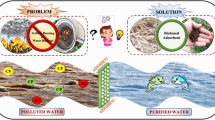Abstract
This concise article essentially centres on the growing need to develop eco-friendly materials to sequestrate diverse contaminants from wastewater. The perspective emphasizes the importance of biodegradable, polysaccharide-based materials such as cellulose and chitosan and the advantages of diverse functional groups such as hydroxyl and amine in these biopolymers. Tailoring these biopolymers with non-toxic metal oxides for enhanced removal is also discussed. Carbonization of biomass is another aspect discussed in the article. Batch laboratory studies, with regard to the adsorption capacity, regeneration, and stability of these customized materials are of paramount importance before applying them in the treatment of larger volumes of wastewater. These features will open the doors for chemists and chemical engineers to work together and evaluate the viability of upgradation using customized biopolymers and carbonaceous materials to treat industrial effluents.
Similar content being viewed by others
Suggested Reading
Rajesh Nagarathnam. Techniques galore: How to select the best one to detoxify contaminants?, ACS EST Water, 1, 1, pp.11–12, 2021, https://doi.org/10.1021/acsestwater.0c00108.
Z. Zia, A. Hartland, and M. R. Mucalo, Use of low-cost biopolymers and biopolymeric composite systems for heavy metal removal from water, Int. J. Environ. Sci. Technol., 17, pp.4389–4406, 2020, https://doi.org/10.1007/s13762-020-02764-3.
J. Kostal et al., Customizable biopolymers for heavy metal remediation, J. Nanopart. Res., 7, pp.517–523, 2005, https://doi.org/10.1007/s11051-005-5132-y.
A. Gallifuoco, A new approach to kinetic modeling of biomass hydrothermal carbonization, ACS Sustainable Chem. Eng., 7, pp.13073–13080, 2019, https://doi.org/10.1021/acssuschemeng.9b02191.
H. B. Sharma, A. K. Sarmah, B. Dubey, Hydrothermal carbonization of renewable waste biomass for solid biofuel production: A discussion on process mechanism, the influence of process parameters, environmental performance and fuel properties of hydrochar, Renewable and Sustainable Energy Reviews, Vol.123, 109761, 2020, https://doi.org/10.1016/j.rser.2020.109761.
Y. Wang et al., Comparative evaluation of hydrothermal carbonization and low temperature pyrolysis of Eucommia ulmoides oliver for the production of solid biofuel, Sci. Rep., 9, 5535, 2019, https://doi.org/10.1038/s41598-019-38849-4.
C. Xu, M. Stromme, Sustainable porous carbon materials derived from wood-based biopolymers for CO2 capture, Nanomaterials, 9, 103, 2019, https://doi.org/10.3390/nano9010103.
E. Khademian et al., A systematic review on carbohydrate biopolymers for adsorptive remediation of copper ions from aqueous environments: Part A: Classification and modification strategies, Sci. Total. Environ, 738, 139829, 2020, https://doi.org/10.1016/j.scitotenv.2828.139829.
J. Kostal et al., A temperature responsive biopolymer for mercury remediation, Environ. Sci. Technol, 37, pp.4457–4462, 2003, https://doi.org/10.1021/es034210y.
G. Mruthunjayappa et al., Engineering a biopolymer-based ultrafast permeable aerogel membrane decorated with task specific Fe-Al nanocomposites for robust water purification, ACS Appl. Bio. Mater., 3, pp.5233–5243, 2020, https://doi.org/10.1021/acsabm.0c00630.
I. A. Udoetok, O. Faye, L. D. Wilson, Adsorption of phosphate dianions by hybrid inorganic-biopolymer polyelectrolyte complexes: Experimental and computational studies, ACS Appl. Polym. Mater., 2, pp.899–910, 2020, https://doi.org/10.1021/acsapm.9b01123.
A. S. K. Kumar et al., Application of cellulose-clay composite towards the effective adsorption and removal of chromium from industrial wastewater, Ind. Eng. Chem. Res., 51, pp.58–69, 2012, https://doi.org/10.1021/ie201349h.
D. Li, A versatile bio-based material for efficiently removing toxic dyes, heavy metal ions and emulsified oil droplets from water simultaneously, Bioresour. Technol., 245, pp.649–655, 2017, https://doi.org/10.1016/j.biortech.2017.09.016.
C. B. Godiya, L. A. M. Ruotolo, W. Cai, Functional biobased hydrogels for the removal of aqueous hazardous pollutants: current status, challenges, and future perspectives, J. Mater. Chem. A., 8, pp.21585–21612, 2020, https://doi.org/10.1039/D0TA07028A.
Author information
Authors and Affiliations
Corresponding author
Additional information
N. Rajesh is a Senior Professor in the Department of Chemistry, BITS Pilani, Hyderabad campus, India. His research interests include development of novel biopolymer and carbonaceous materials for the effective detoxification of heavy metals, fluoride and pesticides from water and industrial effluents. He has been instrumental in developing the undergraduate chemistry teaching and research laboratories from conception to completion at BITS Pilani, Hyderabad campus.
Rights and permissions
About this article
Cite this article
Rajesh, N. Turning the Spotlight on Biopolymers and Carbonized Biomass for Environmental Remediation. Reson 27, 817–823 (2022). https://doi.org/10.1007/s12045-022-1374-6
Published:
Issue Date:
DOI: https://doi.org/10.1007/s12045-022-1374-6




